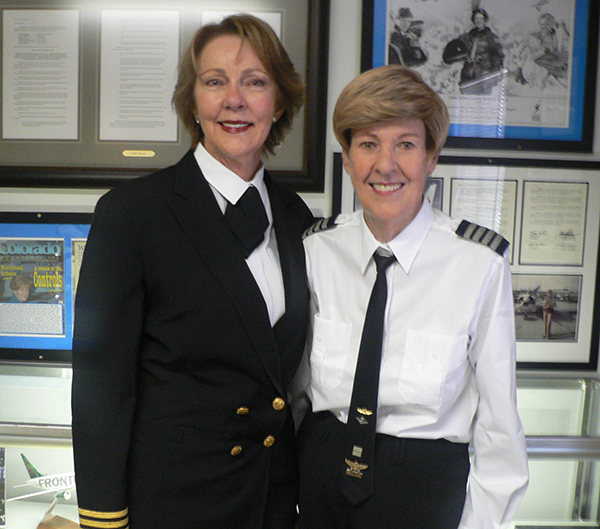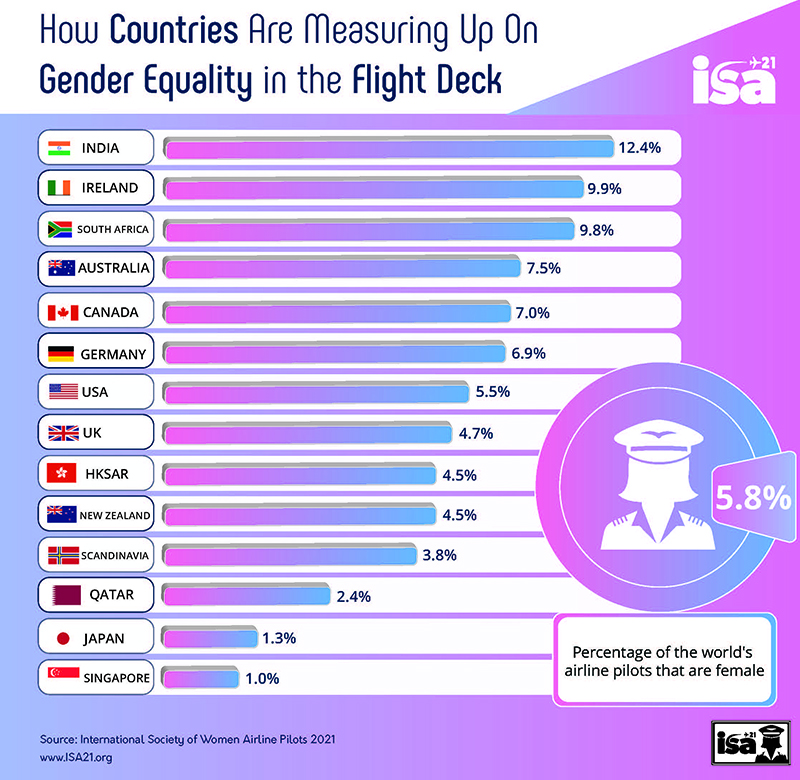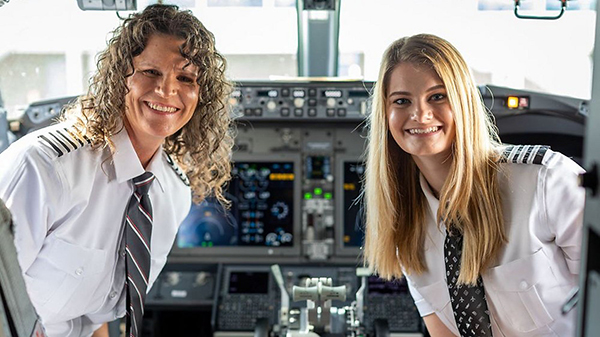Photo above – Female airline pilots continue to make aviation history. Here Captain Holly Petitt on Southwest Airlines flight deck with her daughter, First Officer, Keely Petitt. A first mother-daughter flight crew for the airline on August 5, 2022. (Courtesy Southwest Airlines, Schelly Stone)
By Penny Rafferty Hamilton, Ph.D.
January, 1973, was an historic month in our nation’s history with the end of the Vietnam War. That same month in our airline history, Frontier Airlines hired Denver’s Clinton Aviation Chief Flight Instructor, Emily Howell, as their first female airline pilot. An action which literally made world news.
Early on February 6, 1973, Emily’s first thought was the cardinal rule of every aviator, “fly the plane.” She focused on what she knew so well as a 7,000 hour pilot and flight instructor with multiple ratings. Being the first woman anything is a difficult burden because unfairly your success or failure reflects on all women.
Because Emily was Frontier’s first female pilot, they did not have a uniform for her. Ever resourceful, Emily hired a Denver seamstress. As she slipped her arm through the custom-made airline pilot jacket, her mind momentarily flashed to Jackie Cochran and her specially-made Santiago blue Women Airforce Service Pilot uniforms because the U.S. Army Air Corps did not have uniforms for women pilots. Emily felt even more confidence knowing the WWII WASP blazed sky trails before her.
Passengers headed to Stapleton airport to catch the historic Frontier Boeing 737 flying to Las Vegas might have heard Carly Simon singing the number one song, “You’re So Vain” or even Stevie Wonder’s “Superstition.” Many were unaware their scheduled flight would be recorded in aviation history.
As Emily reached the boarding gate, she heard the commotion from all the media members gathered at the bottom of the flight stairs to record this special moment of the first female airline pilot in modern time. (In 1934, Helen Richey had tried to break into commercial aviation with an airline. However, she was not allowed to join the Air Line Pilots Association and the Federal Aviation authorities restricted her airline flights.)
Emily took a deep breath, smiled, and began climbing the stairs up to the Boeing cabin. Emily could hear the click of cameras documenting aviation history. One of the reporters yelled for her to stop and look back at them. She dutifully obliged. When she finally was quietly situated on the flight deck, the Frontier Flight eventually became airborne. The Air Controllers along their flight path all congratulated Emily and Frontier as they flew to Las Vegas.
With this one flight, Emily Howell smashed the glass ceiling of the sex-segregated airline flight decks in the United States forever. Not long after, American Airlines hired Bonnie Tiburzi as their first female pilot. Concurrently, the young Tiburzi became the first woman in the world to earn a Flight Engineer rating on a turbo-jet aircraft.

Slowly, more women joined airline flight crews. In late, 1975, Stephanie Wallach was hired by Braniff Airways. The following year, Terry London Rinehart and Valerie Jene Walker flew for Western Airlines. Hughes Airwest hired Mary Bush Shipko. American added Angela Masson and Beverley Bass to their airline pilot ranks. By the end of 1976 twenty-two women were flying for U.S. Airlines. That year Emily Howell Warner was upgraded to become our first female Airline Captain.
In 1978, the International Society of Women Airline Pilots (ISA+21) was founded. In 1979, Lt. Lynn Spruill became the first female U.S. Naval aviator to be carrier qualified. In 1985, Spruill would go on to become one of the first six female Delta Air Lines hires.
According to Southwest Airlines Corporate Historian, Richard West, their first female airline pilot was Cathy Jones in May, 1982. In a 1997, Woman Pilot March/April article, SWA CEO, Herb Kelleher, reported 71 women pilots were on their flight crews, of which 26 were Captains. The numbers of women airline pilots has slowly increased with improved career awareness, scholarship programs, and stronger mentoring programs.

A February 24, 2023, USA Today article reported that Airline Pilots received the sharpest pay increase since 2010 of professional positions. The average salary reported was $98,100. The future for women at the airliner controls remain bright. Even today more contemporary women continue to be record-setting firsts in the airline industry.
Several female airline pilots have written books about their careers and challenges. Captain Laura Savino in Jet Boss offers important advice for young women considering an airline career. Mary Bush Shipko, Hughes Airlines first female pilot, titled her memoir, Aviatrix. Captain Lynn Rippelmeyer penned her inspiring airline story Life Takes Wings: Becoming the First Female Boeing 747 Pilot. Of course, Captain Tammie Jo Shults tells the harrowing story of safely landing Southwest Airlines Flight 1380 after a catastrophic engine failure in Nerves of Steel. With her military aviation and extensive airline training, she and her crew saved 148 lives.
These professional airline pilots pushed through adversity and challenges to shatter the glass-ceiling of the airline flight decks. Today, official mentoring projects focus on the support and encouragement many women airline pilots did not have available fifty years ago. The highly successful Girls in Aviation Day and Mentor Connect of Women in Aviation International are important tools to introduce aviation to young minds. Other examples are Sisters of the Skies and the Ninety-nine Professional Pilot Leadership Initiative (PPLI).
Well over one hundred years ago, Harriet Quimby, America’s first licensed female pilot said in 1912, “The aeroplane should open a fruitful occupation for women. I see no reason they cannot realize handsome incomes by carrying passengers between adjacent towns“…” With that thought in mind, the Emily Warner Field Aviation Museum has proclaimed every March 8 to be Celebrate Emily Warner & Women Airline Pilots Day, which is also International Women’s Day!




